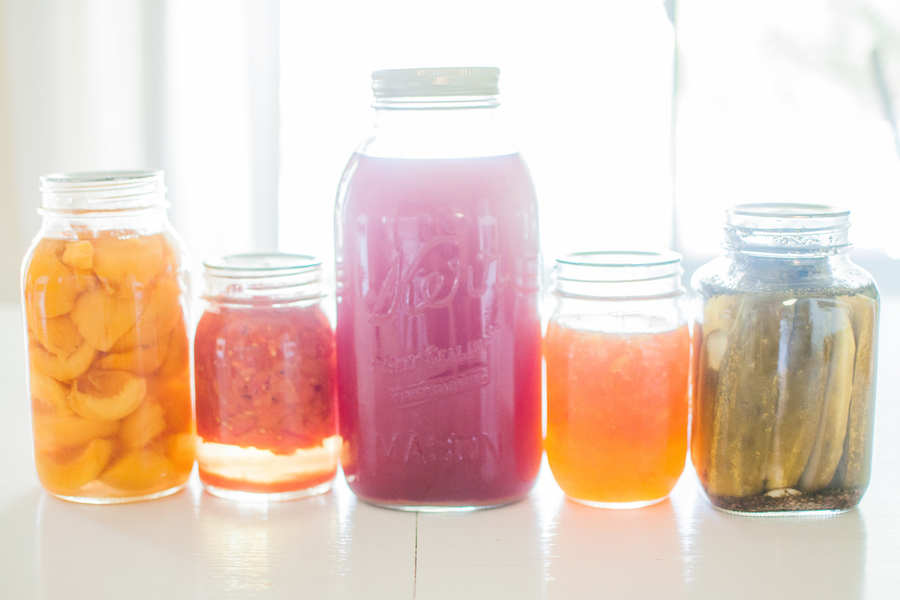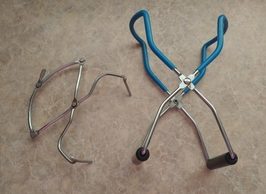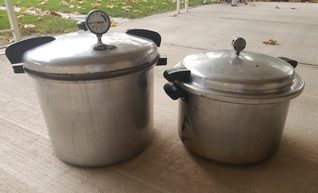
Is Home Canning Safe?
I grew up in a family where we raised a very big garden and all summer we harvested healthy, homegrown food and bottled it for the winter. It was very common. Many families lived that way, and no one worried about it. As time has passed it has become less common and I have sensed a lot of fear from people thinking they would kill their family or at least make them sick if they tried to bottle their own food. I would like to address the possible issues with home canning and hopefully alleviate some fears.
Is home canning safe? The answer is: Yes! There are some guidelines that must be followed, but they are not difficult. It will help if you understand the potential problems. The possible issues are very limited. There are actually only two.
- Spoiling
- Botulism
As we talk about canning we will divide food into two categories: High Acid Foods, and Low Acid Foods.
High Acid Foods:
These foods are not susceptible to botulism so they have fewer requirements. If you feel at all uncomfortable in home canning this is where you should start. These foods include fruits, jams, jellies, and pickles. The only issue you may have bottling these foods is spoiling.
Spoiling – Let’s talk about spoiling. First of all, even though eating spoiled food would make you sick it is not a danger in bottled food because if it is spoiled it will be obvious. It will look bad. It will smell bad. You will not want to eat it.
That being said, even though it isn’t necessarily a danger, you don’t want to waste your time and food by doing it wrong and having it spoil. Spoiling is caused by a bacteria that is always present in food. If the food is heated to boiling the bacteria is killed. In the case of home canning, the food is placed in jars and then heated until the temperature throughout the food is hot enough to kill the bacteria and then it is sealed in a vacuum.
The most likely reason for food to spoil in home canning is that the jars were not processed long enough for the heat to penetrate to the very center of the food.
The way to avoid this is:
- Start timing after the pot is boiling
- Follow the recommended processing times
The other possibility for canned food to spoil is that the jar didn’t seal. Occasionally this just happens. Check the seals on your jars before you put them in storage. If one or two didn’t seal you can store them in your refrigerator until you eat them. When you have a good seal on your bottle you can remove the ring and it will stay sealed.
This video shows how to tell if the jar is sealed.
How to bottle high acid foods
I will go into more details for bottling specific fruit, pickles, and jams in other posts, but in general, they are the same. When canning high acid foods you can use a method called a Boiling Water Bath. The length of time the jars are in the boiling water bath is called the processing time.
- You will need a pot tall enough to cover the jars with water. It doesn’t necessarily have to be a canning pot. Sometimes I use a stock pot if I don’t have enough jars to fill my big pot. When you buy a canning pot it will have a rack in the bottom of it. This is important so the jars won’t sit right against the heat which could cause them to break. If you want to use a pot that doesn’t have a rack you can put old canning lids in the bottom for the jars to sit on.

- You will need canning jars with lids and rings. According to the manufacturers, the lids are for one use only, but the rings and the jars can be used over and over.
- You will need canning tongs to remove the hot jars from the pot.

Cold-Pack Canning For me the easiest and quickest method to bottle fruit is to cold-pack the jars.
- Wash the fruit
- Remove the skin if desired (some fruits such as peaches and pears are usually skinned, others such as apricots are not)
- Place fruit straight into bottles
- Add sugar for flavor. Sugar is optional, it is a matter of preference in canning fruit. I usually do ¼ cup per quart.
- Fill the jars with water just below the neck of the bottle.
- Wipe the rim of the jar so that it is perfectly clean
- Boil the lids
- Place the hot lid on the jar, screw the ring on to hold it in place
- Place jars into a large pot, and cover completely with water
- Bring it to a boil (this is the boiling water bath)
- Start timing after the water is boiling. 20 min for pints, 30 min for quarts (There are charts with processing times for specific fruits that require less. The times I have listed are pretty generous for everything)
- Using canning tongs remove jars from hot water and allow to cool. Do not leave them in the water to cool. They will seal as they are cooling. You may hear pops as the jars seal.
- When they are cool you may want to wash the bottles and remove the rings.
*note: when you are doing one batch after another you don’t want to put cold jars in the already boiling water because you may crack your jars. I always remove a couple of quarts of boiling water and replace it with cold water and then gently place the next batch of jars in.
This process of canning is actually very simple. It doesn’t require a lot of expensive equipment, and there is no danger at all. It’s a great project! Go ahead and give it a try.
Low Acid Foods
Low acid foods include vegetables, meats, and legumes. Because of the low acidity levels in these foods, botulism is a possibility so they have some extra requirements which if followed make them safe.
Botulism – Although botulism is rare it is dangerous and so should be taken seriously. Food with botulism won’t look, smell or taste bad so it is essential that care is taken to prevent it.
Botulism is a spore that floats around in the air. We breathe it in, we drink it and eat it. In that form, it is perfectly harmless. But given the right conditions, it grows into a deadly toxin. The conditions required are low acid and little or no oxygen, such as in the vacuum of a sealed jar.
The toxin itself is easily killed by heating the food to 85 degrees Celsius (185F). So any food that is brought up to boiling after it comes out of the jar is safe to eat even if it had the toxin in it. The concern is that some foods might not be reheated before eating, such as salsa that is typically eaten right out of the jar.
Our goal in canning low acid foods is to kill the spore so it can’t grow into a toxin. Spores are more difficult to kill. The food must be heated to 121 degrees Celsius (250F) and maintained for 3 minutes. Since this is above the boiling temperature of water it requires a pressure canner. I have noticed that many people feel uncomfortable using a pressure canner but there is no need to fear. As long as we follow the recommended times and pressures in pressure canning it is perfectly safe.
There are many different pressure canners. Some have a gauge on the lid. Some have only a weight, and some have both. You will want to follow the manufacturers instructions on your particular canner.

I have provided a link to a chart of recommended processing times. Click here
Canning Tomatoes
Tomatoes are kind of in a group by themselves. In the past, they have always been treated as a high acid food and bottled just like fruit. But because newer varieties are less acidic it has been recommended that they are either pressured or processed in a water bath for longer times. Another option for tomatoes is to add a little vinegar, lemon juice, or citric acid to make them safe for water-bath canning.
For one quart add: 2TBS lemon juice
or 4TBS vinegar
or ½ tsp citric acid
To offset an acid taste you make want to add a little sugar.
Home canning is a very satisfying way to provide healthy, homegrown, organic food for our families. It can be done very safely. There is no need to fear.
